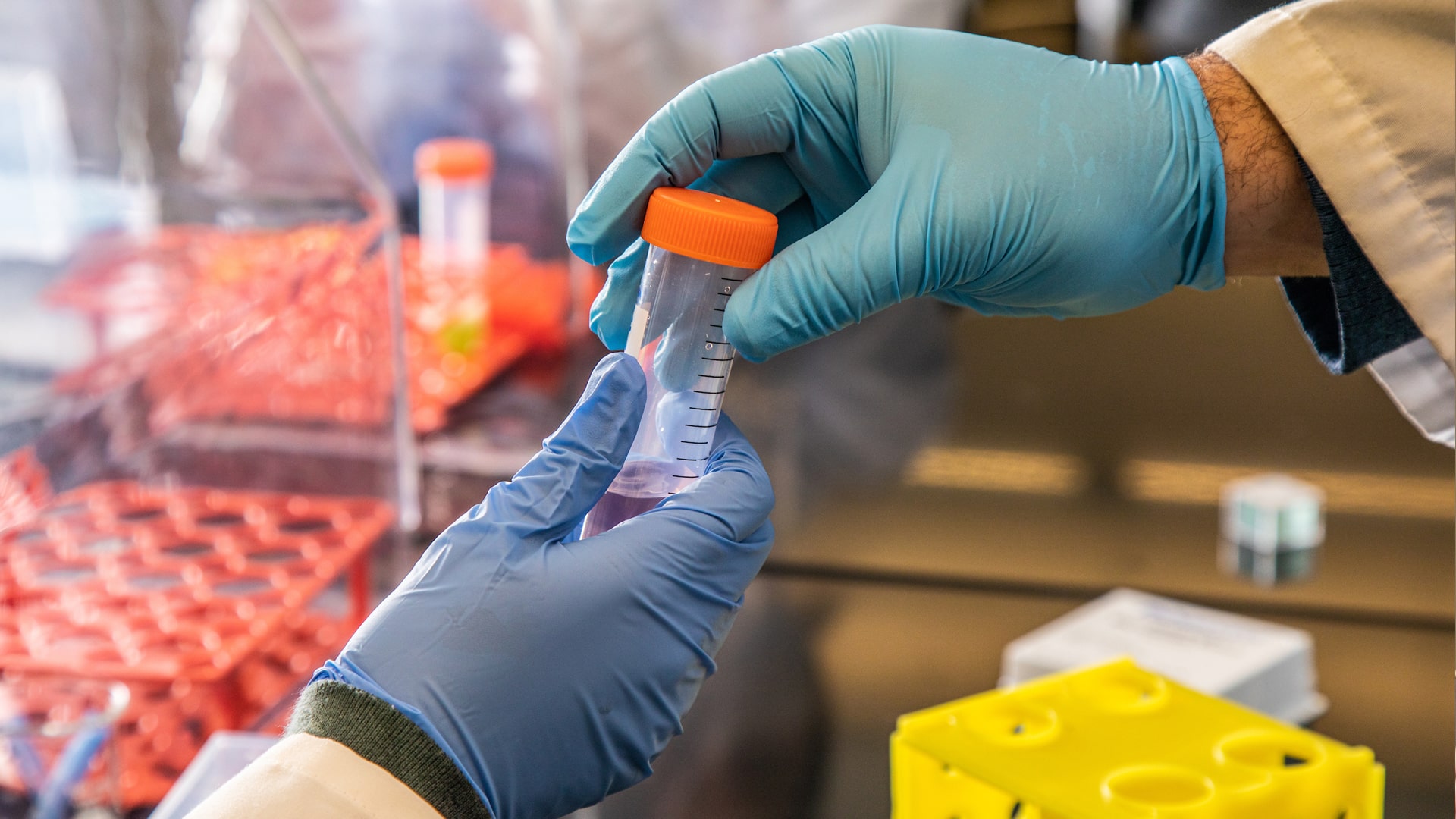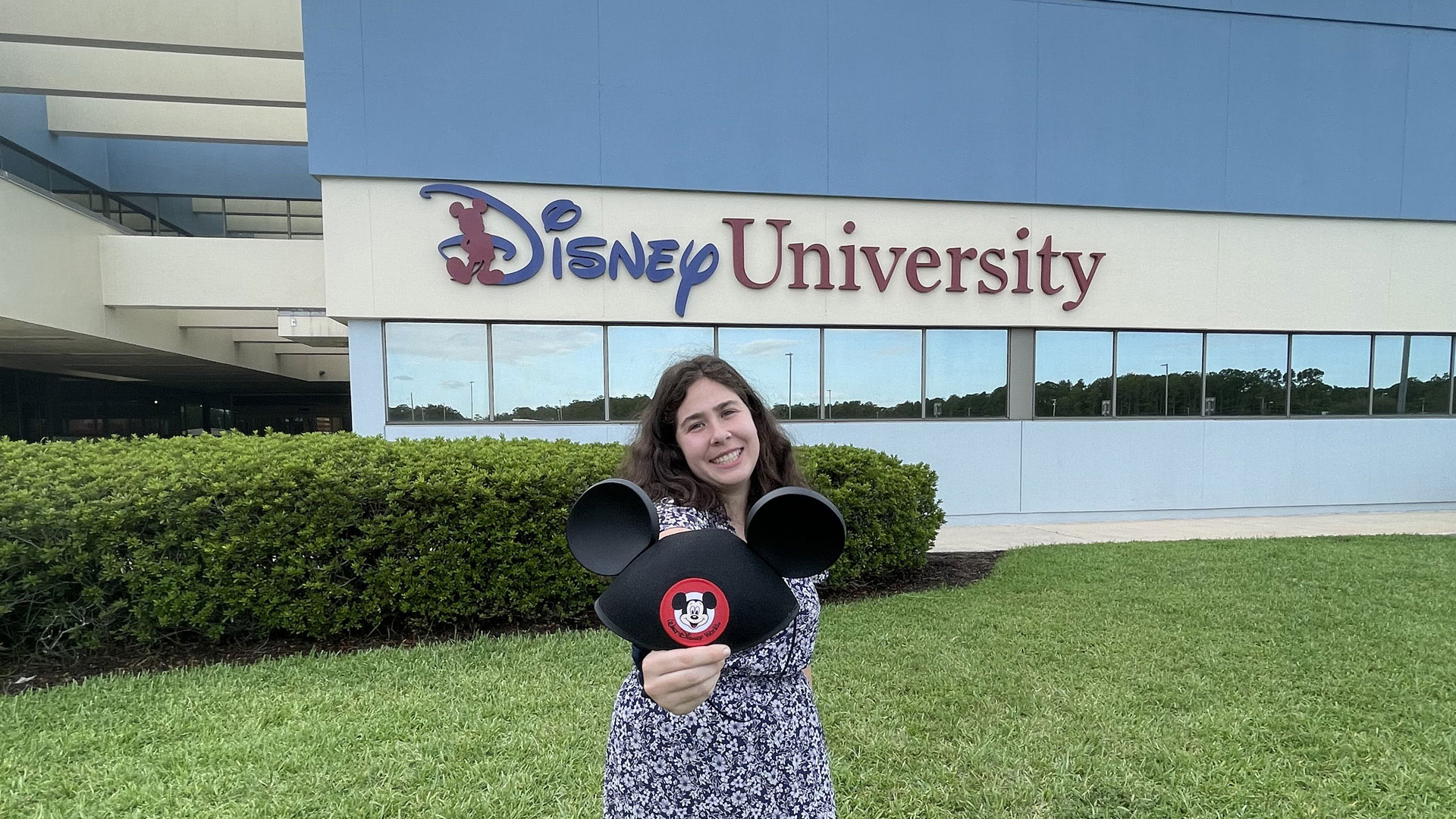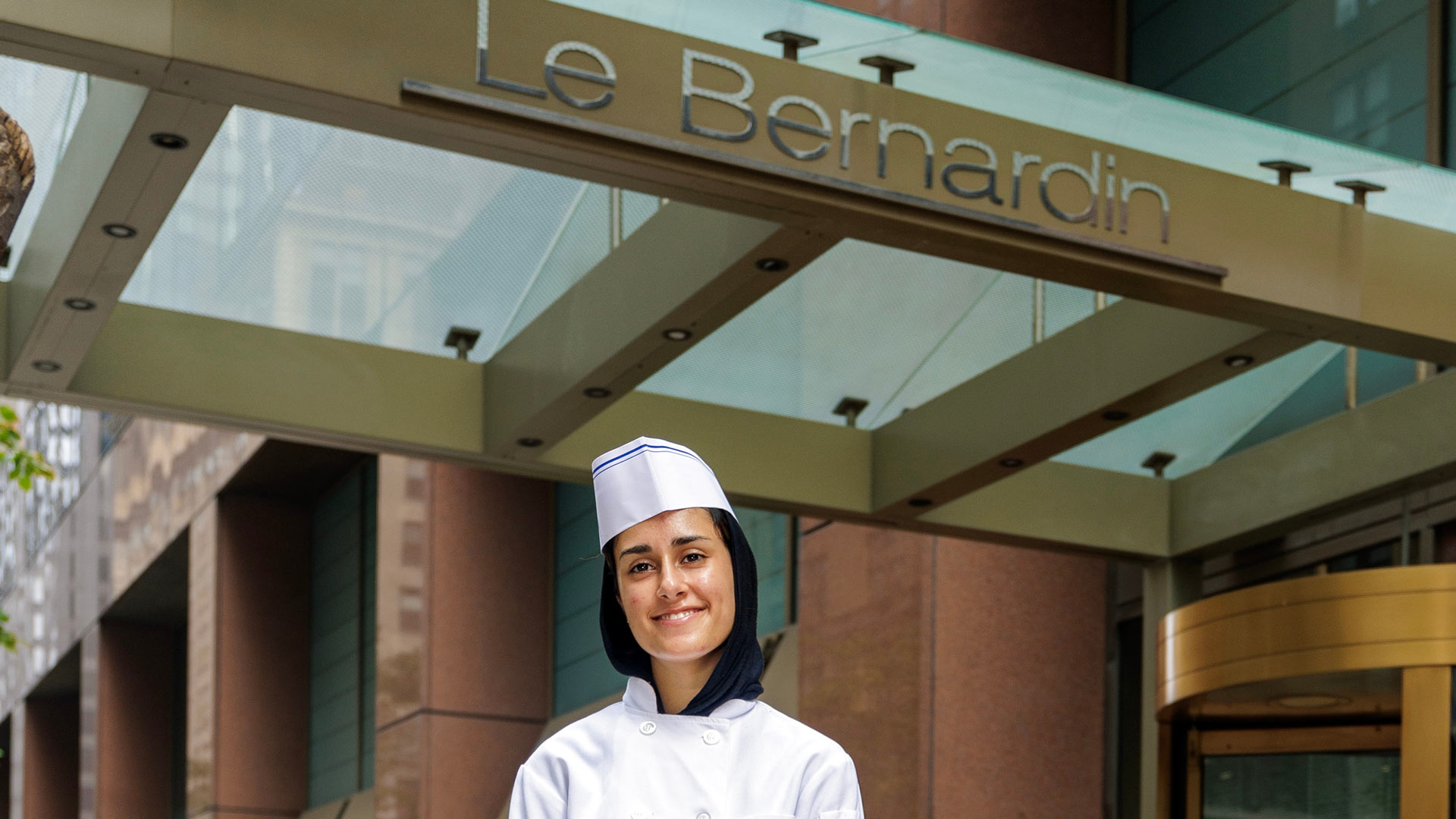Student Symposium Powers Innovation, Inspires Change
JWU’s 2025 Student Research, Design & Innovation Symposium brought together students, faculty and staff to celebrate students’ creative and inventive work. This annual event, held at both the Providence and Charlotte Campuses, is an opportunity for students to highlight their accomplishments, research and scholarship.
This year more than 100 projects were developed, displayed and presented by undergraduate and graduate students representing all JWU colleges. Each project centered on real-world problem solving across industries and ranged from the effects of mindfulness on academic performance, to a device that tests for concussions and a campus organization to support students dealing with food insecurity. Here are some examples of the award winners from both campuses.
Providence Campus
Testing for Life Threatening Injuries
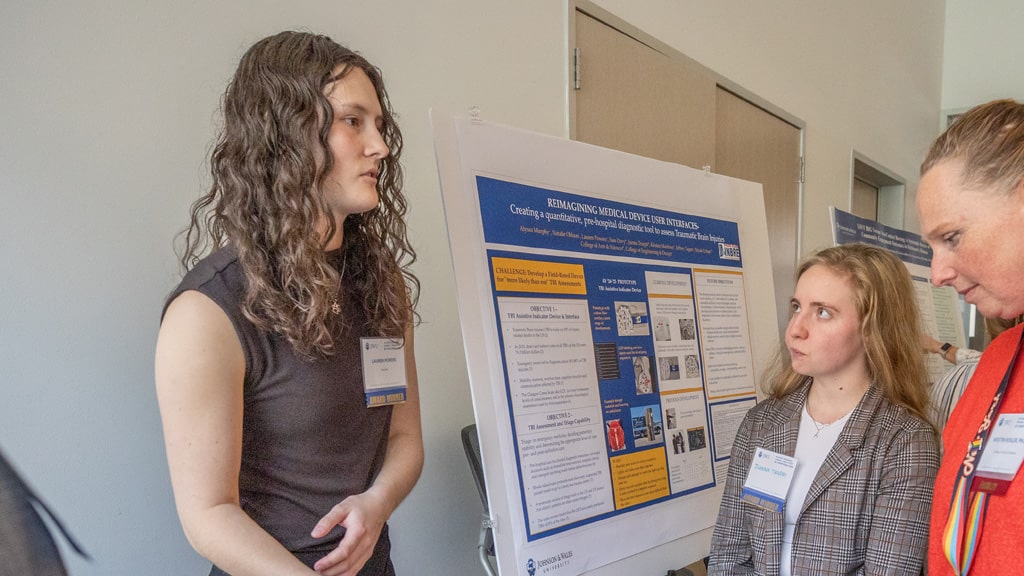
Lauren Powers ’25 explains how the device, that tests for concussions, works.
The President’s Choice Award-winning “Field-Based Device to Test for Possible Concussions” evaluates people with head injuries for a concussion by testing their reaction time. The device’s touch-sensing buttons light up in a pattern that the injured person has to repeat while touching the buttons as fast as possible.
“The device records the time it took them to complete the test. If the score shows that it is ‘more likely than not’ the person has a concussion, they need to go to a hospital,” shared Lauren Powers ’25, Biomedical Engineering major, who developed the device along with Samantha Davy ’27 and Jianna Truppi ’25, both Biology majors.
Creating Brand Identity: Inspiration, Design and Function

Matteo Lopergolo ’25, shows off the brand standards guidebook he created.
Matteo Lopergolo ’25, a Graphic Design major, developed a comprehensive brand standards guidebook for a fictitious brand, Veritas International Airlines. The guidebook communicates the brand's identity and ensures consistent use of the brand’s visual and messaging elements, along with detailed guidelines for using logos, colors, typography and tone across various mediums and contexts.
“I came up with this project after doing a logo challenge in class and used one of the logos I created to expand on and develop it into a whole logo system. I was inspired to do this project by my passion for editorial layout and blending visually appealing design with functionality,” explained Matteo.
Studying Positive Effects of Mindfulness on Students
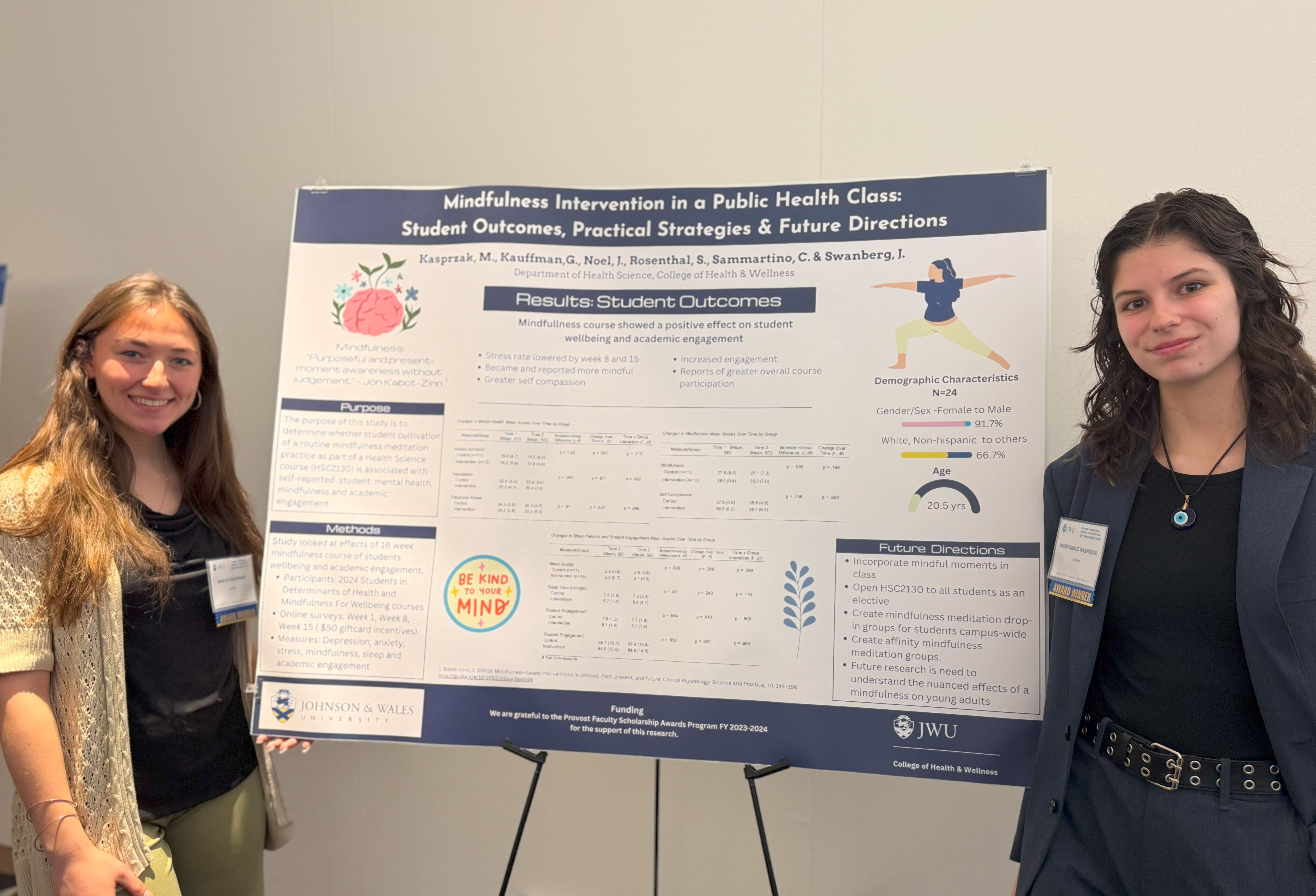
MaryGrace Kasprzak ’27 and Gracie Kauffman ’27 with their poster presentation on students using mindfulness.
The goal of this mindfulness intervention experiment was to assess the impact of mindfulness meditation practice on academic performance, engagement and overall student well-being in a college setting. The experiment was conducted using two health sciences courses; one as the control group and the other, which incorporated mindfulness practices throughout the semester, as the intervention group. The students’ progress was tracked through three surveys they filled out during the semester. The findings showed that although the sample size was too small for conclusive results there was a trend showing a reduction in student anxiety in the intervention group and a significant difference in the anxiety levels between the mindfulness scores of the two groups.
“We are developing the information from the presentation poster into a manuscript and hope to have it published in a scientific journal,” said MaryGrace Kasprzak ’27, who developed the project with Gracie Kauffman ’27, both Health Science majors.
Helping People with Communication Challenges Get their Message Across
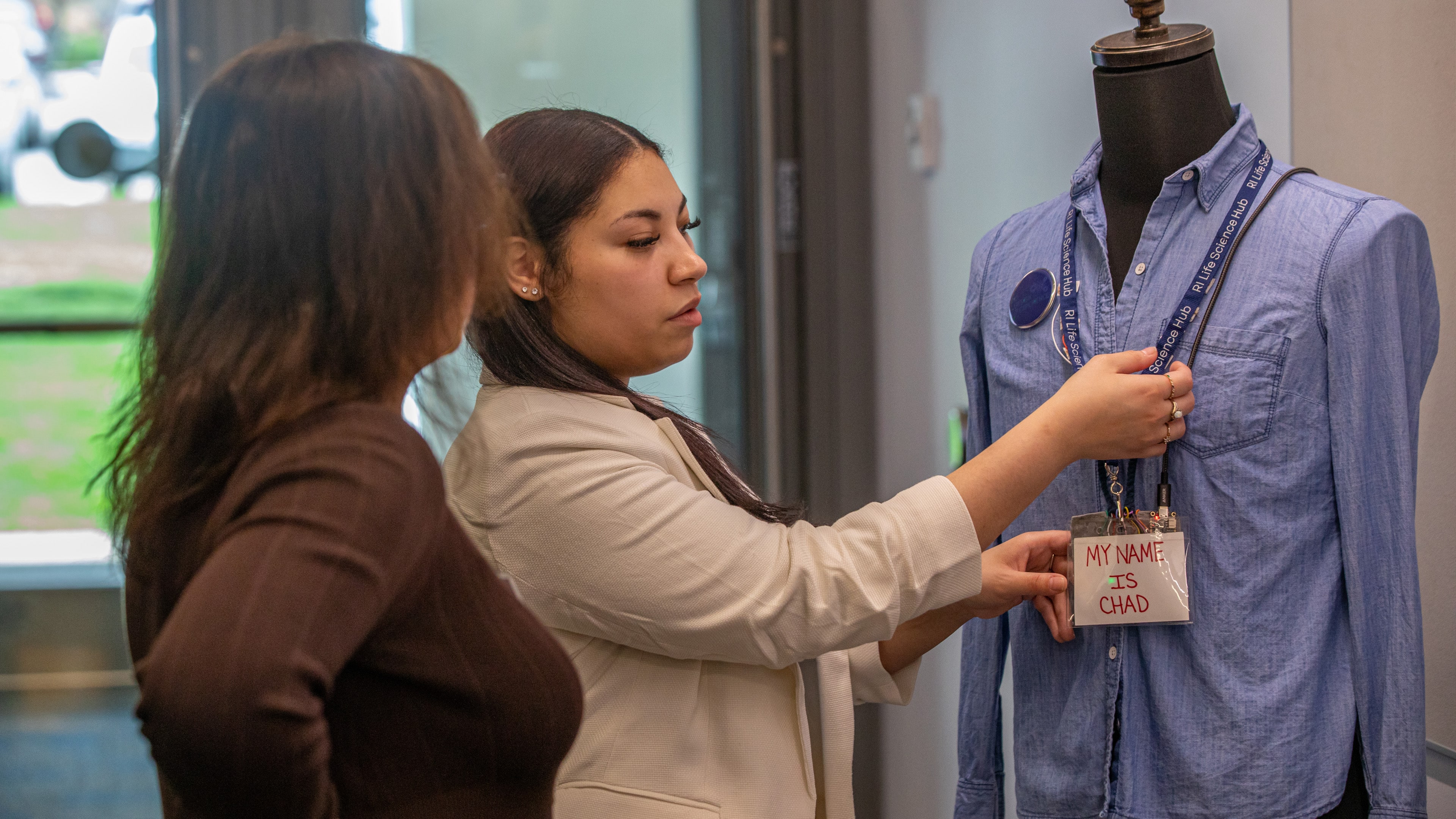
Valerie Rosario ’25 shows attendees how her AAC device could help people with communication challenges.
Augmentative and Alternative Communication (AAC) devices help people with verbal communication challenges, including English language learners and individuals who are hard of hearing, on the autism spectrum or have anxiety disorders. Valerie Rosario ’25, a Biology major, developed the prototype with integrated touch-sensing panels and small LCD screens into wearables including necklaces and lanyards. The device allows for customizable, on-demand communication and its users can incorporate different commands and messages for use in more than one environment, such as home and work.
Valerie was inspired to develop her prototype after an experience during a class. “I failed because I was having social anxiety — every time I got up to speak, I froze. So, I know firsthand how it feels to know what you want to say but you cannot get the words out.”
Charlotte Campus
Shaping Greener Drinks for Modern Consumers
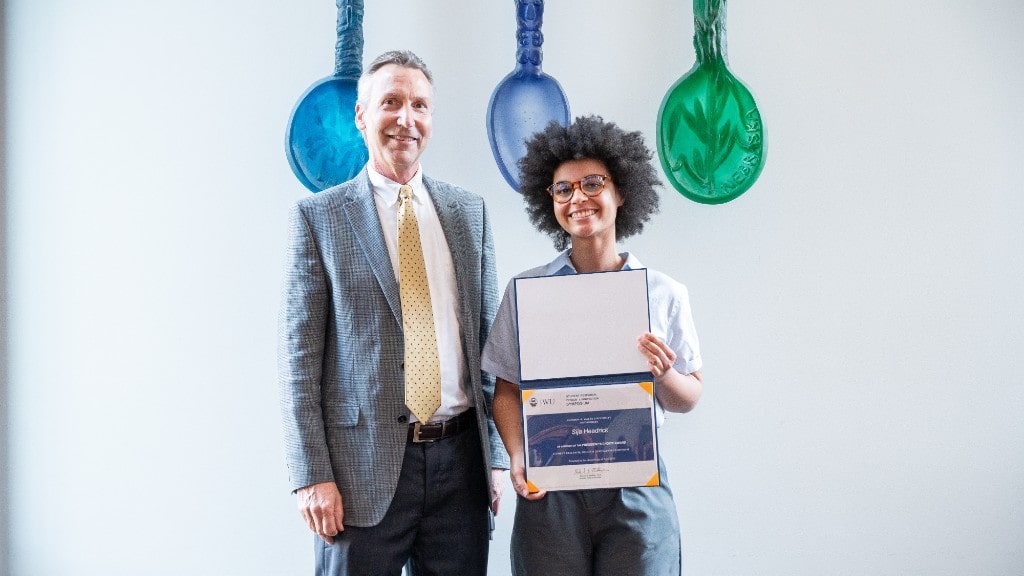
Charlotte Campus President Richard Mathieu, Ph.D. and Sija Headrick ’25.
The concept for this President’s Choice Award-winning project, “Moonbeam — Crafting a Greener Future for RTDs,” reimagines the ready-to-drink (RTD) beverage market through an eco-conscious lens and impressed judges with its integration of sustainability and innovation. While developing Moonbeam, Food & Beverage Industry Management major Sija Headrick ’25 investigated emerging trends in the market, focusing on 25 to 35-year-olds, who value both high-quality products and sustainability. That research led to the challenge of tackling packaging waste and its environmental impact.
Fighting Hunger with Campus-Grown Ingredients
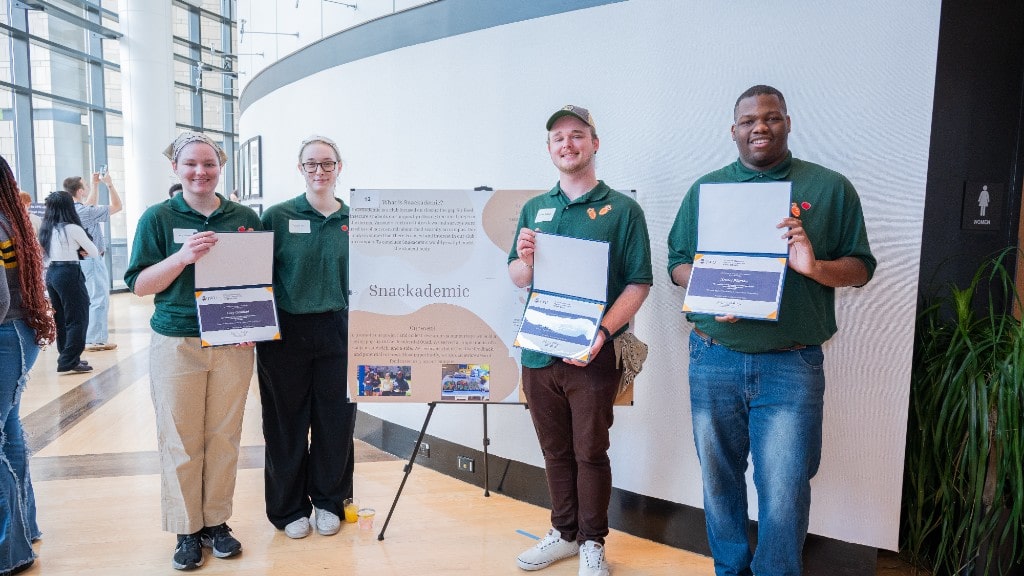
Vanessa Dryer ’25, Lucy Gearhart ’25, Austin Ballard ’25, Xolani Pittman ’25 with their poster presentation for “Snackademic."
Snackademic is a proposed campus organization aimed at helping students with food insecurity that also promotes sustainability. Excess food from The COOP, the campus community garden, would be used to prepare meals for students through the residential hall’s kitchens. The meals would be free and would be promoted through fliers containing the menus and descriptions.
“One of the biggest issues that students face is food insecurity, so it felt right to do something about it,” said Austin Ballard ’25, a Food & Beverage Entrepreneurship major, who developed the concept with Vanessa Dryer ’25, Food & Beverage Entrepreneurship major; Xolani Pittman ’25, Media & Communication major; and Lucy Gearhart ’25, Entrepreneurship major.
Turning Food Waste into Culinary Innovation
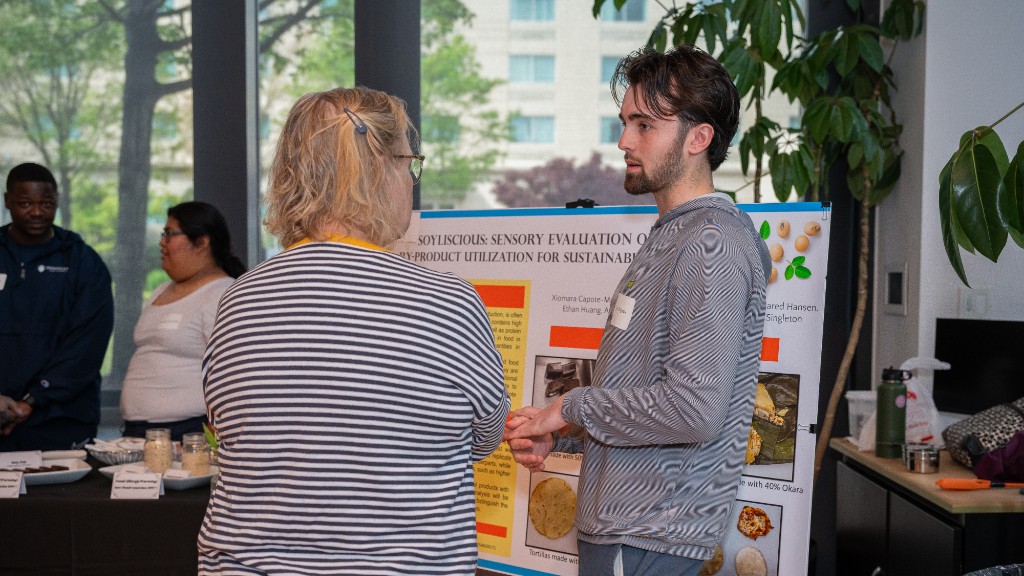
Kyle James Duggan ’25 explaining his concept for creating nutritional food products while reducing food waste.
Okara, a byproduct of soy milk and tofu production, is commonly used in food in Asian countries but is largely discarded in Western countries, despite its nutritional value — high levels of fiber, protein and calcium. Kyle James Duggan’25, an Applied Food Science major, explained how “Soyliscious: Sensory Evaluation of Soy By-Products” aims to create Okara-based food products that are marketable and consumable in the West while ensuring they are also nearly indistinguishable from their counterparts, such as tofu. A sensory analysis test will measure the likelihood of introducing Okara-based food products into the Western market. Another goal of the project is to reduce food waste and promote sustainability by enjoying the Okara rather than disposing of it.”
Fueling College Athletes with Smart, Fast Food
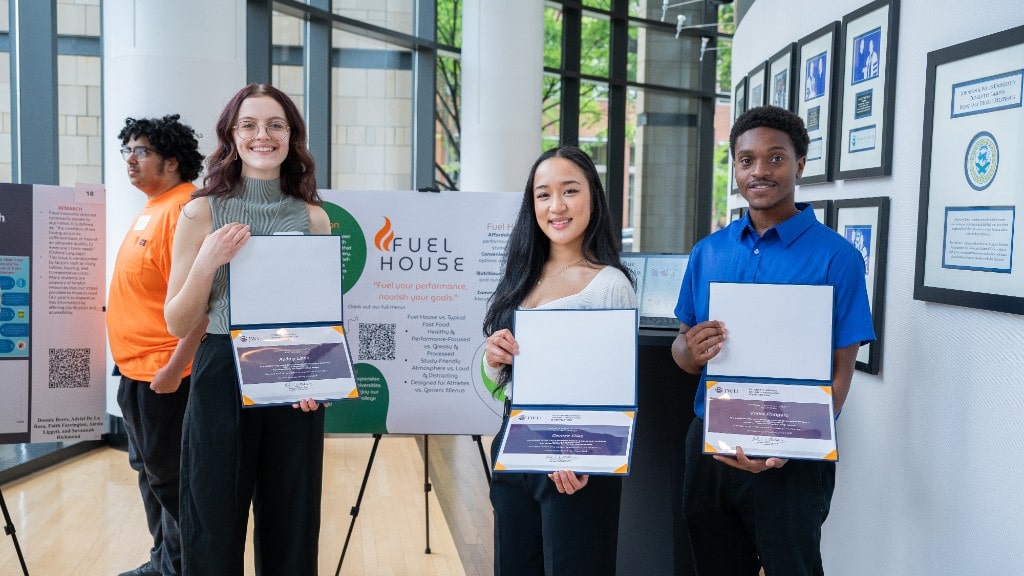
Audrey Linek ’25, Denise Diaz ’26, and Vante Rodger ’26 with their poster for “Fuel House: Healthy Fast Food for College Athletes.”
The Fuel House project explored the creation of a fast-casual dining concept designed to address the unique nutritional needs of college athletes. Recognizing the demand for balanced, high-performance meals, Fuel House would feature nutrient-dense, affordable options that support athletic performance and overall health, emphasizing high-protein, high-carb meals. The restaurant’s environment would foster a quiet, focused atmosphere for studying, making it comfortable for college students. The project was created by Mali Towe ’25, Culinary Nutrition major; Audrey Linek ’25, Baking & Pastry Arts major; Denise Diaz ’26, Culinary Nutrition major; and Vante Rodger ’26, a Food & Beverage Entrepreneurship major.
While all projects presented at the symposium highlighted the excellence and real-word impact of the students’ research, 18 projects were chosen as award winners for their standout, unique concepts.
Providence Campus Award Winners
President’s Choice Award
Field Based Device to Test for Possible Concussions
Lauren Powers ’25, Biomedical Engineering; Samantha Davy ’27, Biology; Jianna Truppi ’25, Biology
Syncope and Fainting Detection Device
Aaliyah Couto ’25, Biomedical Engineering
A Restaurant Built for the Community
Zoe Gross ’28, Culinary Arts
Mindfulness in a Public Health Class
MaryGrace Kasprzak ’27, Health Science; Gracie Kauffman ’27, Health Science
Accessibility in Hospitality
Marina Kearns ’26, Hospitality Management
Veritas Brand Guidelines Book
Matteo Lopergolo ’25, Graphic Design
Impact of Trauma-Informed Care Higher Education
Lauren Mochnal ’26, Occupational Therapy Doctorate
Building Adolescent Wellness through Fitness
Serena Mora ’26, Occupational Therapy Doctorate
Restrictive Masculinity and Depression
Abigail Nosal ’26, Health Science
Wearable Lanyard ACC for On-Demand Communication
Valerie Rosario ’25, Biology
Medicaid Expansion and Black Maternal Mortality
Michaela Siver ’25, Physician Assistant Studies
Social Media and Depression in College Students
Jadyn Torres ’26, Biology
Charlotte Campus Award Winners
President’s Choice AwardMoonbeam — Crafting a Greener Future for RTDs
Sija Headrick ’25, Food & Beverage Industry Management
JWU Engagement
Snackademic
Austin Ballard ’25, Food & Beverage Entrepreneurship; Vanessa Dryer ’25, Food & Beverage Entrepreneurship;
Xolani Pittman ’25, Media & Communication Studies; Lucy Gearhart ’25, Entrepreneurship
Food & Beverage Development
Fuel House — Healthy Fast Food for College Athletes
Mali Towe ’25, Culinary Nutrition; Denise Diaz ’26, Culinary Nutrition; Vante Rodger ’26, Food & Beverage Entrepreneurship; and Audrey Linek ’25, Baking & Pastry Arts
Community Engagement
Plate it Forward Culinary Incubator
Gabrielle Smith ’26, Food & Beverage Entrepreneurship
Fundraising
Community Kitchen
Adriel De La Rosa ’25, Business Administration
Sustainability
Soyliscious — Sensory Evaluation of Soy By-Products
Kyle James Duggan ’25, Applied Food Science
